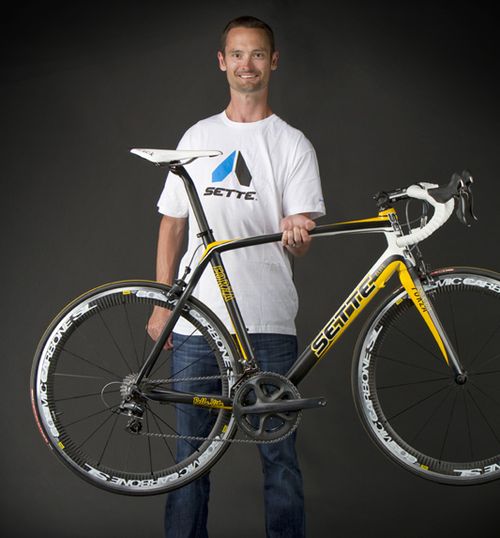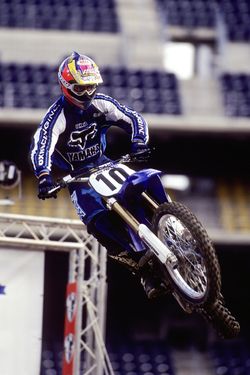
In 2000, former professional motocross rider Jimmy Button suffered a freak crash that instantly paralyzed him from the neck down. Eleven years later, the rehabilitated 37-year-old is hopping on his bicycle for a two-month, 2,428-mile ride from San Diego, California to Daytona, Florida, averaging 60 miles a day to raise money for spinal cord research. He pedals out from Qualcomm Stadium—the site of his accident—on Sunday, following the San Diego Supercross race. I got a hold of him to get the lowdown on the big ride and his long process of recovery.��
–Nick Davidson
What happened at Qualcomm?
It was just a small crash in the big scheme of things. We were in the third round of the Supercross series, and it was our second practice of the day. They gave us the green flag, and I was just cruising around the track really slowly, just a couple of miles per hour, looking at the track and doing a lap before we really started picking up the pace. And I just hit a hole the wrong way. The front end got away from me, and I didn't get my hands out. I landed on my head and wrenched my neck so far backwards that it ripped all the ligaments off my spine and pinched my spinal cord. The second I hit the ground, I went cold and numb. Instant, one-hundred percent paralysis from the neck down.
How long were you paralyzed?
It was a couple of months before anything started to work. The first thing was the index finger on my left hand. I just stared at it, stared at it, stared at it. It may have been hours. I got a finger to move, and the next day I got a little bit more to work. Slowly and eventually the movement started to go across the rest of my body. Months later, I was able to walk on my own. It wasn't a pretty sight in the beginning.
How fully have you recovered use of the paralyzed muscles?
Depending on the day, somewhere between 85 and 95 percent. It took me about six years to get to that point. By 2006 I was starting to feel pretty comfortable getting around, not being petrified all the time that something would go wrong. I still have mishaps every now and again. I'll trip and fall for no apparent reason. But even to this day, I still have small improvements—getting a little stronger, better balance—even after 11 years.
Why were you able to recover where others wouldn't?
The bruise on my spinal cord is still there. It just so happened that the position of the bruise allowed me to have the recovery I did. You could have a bruise on the cord at the same level as mine one tenth of a millimeter to the right or left and still be in a wheelchair. There's no rhyme or reason to it. A lot of doctors aren't sure why I recovered. I've definitely been blessed.

For me, it's a great starting point. It was a finishing point of one part of my life, and now I'm flipping the page to a different chapter. I'm also still very involved in the Supercross and motocross world, so if I'm going to ride a bike coast to coast, I might as well tie it in with the race in San Diego. ��
What's Miles for Miracles all about?
After I got hurt, I started a foundation called Road2Recovery for injured motocross racers, and that's been running for ten years now with a lot of success, which is great. But I was really moved by a program I saw on 60 Minutes with Dr. Keirstead at the Reeve-Irvine Research Center speaking about the developments they're making with stem cells and repairing the spinal cord after an injury. I just felt compelled to contribute to what those guys are working toward. That was the springboard that got Miles for Miracles off and running. So I called my old trainer, Cory Worf, who was with me before I got hurt and stayed with me through my rehabilitation, someone I have a lot of trust and faith in. I asked him if this was something my body physically could withstand. He said with the right training I'd be able to do it, and we started working toward this goal to cycle across the United States the very next day.��
How have you trained for the ride?
In the beginning, it was about as basic as you can get, which was getting to the point where I could ride a stationary bike for an hour. I worked up to two, then got a road bike and set that up on rollers. August was the first time I had actually gone outside on a bicycle under my own power and balance since I had gotten hurt. Once I got outside, I was already fairly fit and building up to three and four hours. During the actual ride, though, we're not riding more than two hours at a time without taking a break for food and rest.
What do you expect to see and experience along the way?
Well, hopefully no crashes. That would be the first thing I would like to not experience. Growing up racing motocross, you travel across the United States, and in a way you see the country, but you see it at 70 miles per hour in a car. Often, you're sleeping to rest before a race. So I think it will be cool to see the country at 15 miles per hour over a period of two months. We've had a lot of people sign up on the Web site to join us for a day or two, so it'll be fun riding with different people and sharing experiences with them. I'm hoping the winds stay at our backs.
Photos courtesy of Simon Cudby Photo.